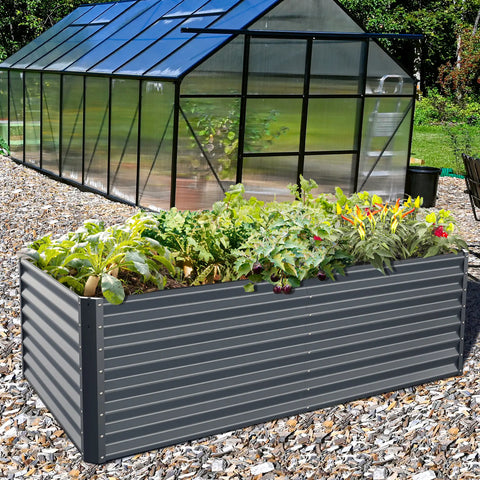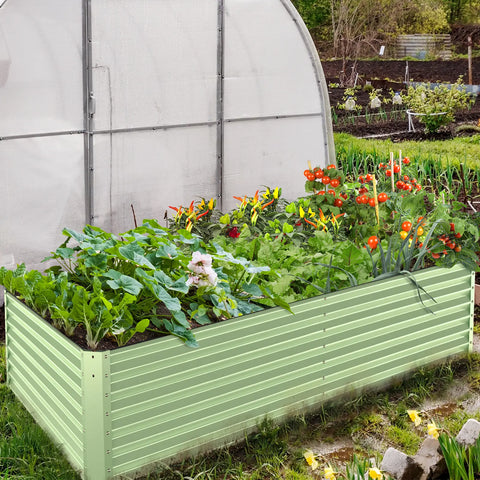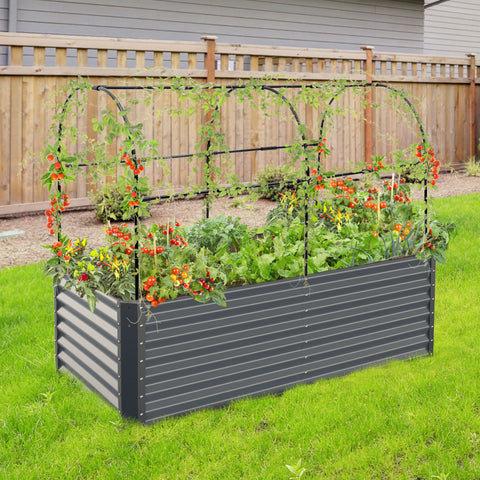Imagine stepping into your backyard and plucking fresh, ripe fruit from your very own miniature orchard. It's not a distant dream; you can make it a reality by growing dwarf fruit trees in raised beds. In this blog post, we'll explore the world of dwarf fruit trees, the benefits of raised beds, and how to create your own mini orchard at home.

The Appeal of Dwarf Fruit Trees
Dwarf fruit trees have gained popularity among home gardeners for several compelling reasons:
- Limited Space: Dwarf trees are compact and well-suited for small gardens, patios, or even balconies. They make fruit growing accessible to urban and space-constrained gardeners.
- Easy Maintenance: Their smaller size makes them more manageable in terms of pruning, harvesting, and overall care.
- Faster Fruit Production: Dwarf trees typically bear fruit earlier than standard-sized trees, which means you can enjoy the rewards sooner.
- Adaptability: They can be grown in containers, raised beds, or directly in the ground, giving you flexibility in choosing your preferred planting method.
- Aesthetic Appeal: Beyond their practical benefits, dwarf fruit trees add beauty to your outdoor space, especially during the blossoming and fruit-bearing seasons.
Advantages of Raised Beds
Raised beds offer unique advantages when it comes to growing dwarf fruit trees. Here are some of the benefits:
- Improved Drainage: Raised beds provide excellent drainage, which is crucial for preventing waterlogged soil that can harm fruit trees.
- Better Soil Control: You can customize the soil in raised beds, ensuring it's rich in nutrients and well-suited for fruit tree growth.
- Warmer Soil: Soil in raised beds warms up faster in the spring, allowing you to start planting earlier in the season.
- Elevated Growing Space: Raised beds bring fruit trees to a convenient height, reducing the need to bend or kneel during maintenance tasks.
- Pest Control: In many cases, raised beds can be easier to protect from pests and critters that might otherwise damage your fruit trees.

Selecting the Right Fruit Trees
When choosing fruit trees for your mini orchard, consider the following factors:
- Climate: Select fruit tree varieties that are well-suited to your local climate and weather conditions.
- Compatibility: Some fruit trees are self-pollinating, while others require a partner tree for cross-pollination. Ensure that you select varieties that work well together.
- Size: Confirm that the fruit tree varieties you select are available in dwarf or semi-dwarf sizes.
- Personal Preferences: Choose fruit trees that produce fruits you and your family enjoy. Consider factors like flavor, texture, and intended culinary uses.
- Disease Resistance: Some fruit tree varieties are more resistant to diseases and pests, which can make your gardening experience more enjoyable.
Planting and Caring for Dwarf Fruit Trees in Raised Beds
Here are the steps to successfully plant and care for dwarf fruit trees in raised beds:
1. Choose the Right Location
Select a sunny spot for your raised bed with at least 6-8 hours of direct sunlight. Ensure there's proper air circulation around the trees to prevent diseases.
2. Prepare the Raised Bed
Fill your raised bed with well-draining soil. Incorporate organic matter and compost to enrich the soil with nutrients. The raised bed should be deep enough to accommodate the root system of your chosen fruit trees.
3. Plant the Trees
Plant the dwarf fruit trees according to the recommended spacing for each variety. Ensure that the trees are level with the surrounding soil in the raised bed.
4. Mulch
Mulch around the base of the trees with organic mulch, which helps retain moisture, suppress weeds, and regulate soil temperature.
5. Watering
Provide regular and consistent watering. Dwarf fruit trees typically require about 1 inch of water per week. Use a drip irrigation system to ensure even moisture distribution.
6. Pruning
Pruning is essential for maintaining the shape and size of your dwarf fruit trees. Remove dead or diseased branches and shape the tree to encourage healthy growth.
7. Fertilization
Dwarf fruit trees benefit from regular fertilization. Use a balanced fruit tree fertilizer and follow the recommended application rates.
8. Pest and Disease Control
Watch out for any signs of diseases or pests on your trees. Early intervention is key to preventing potential problems. Consider using natural techniques to manage pests and diseases.
9. Thinning
When the fruit trees bear fruit, thin the fruits to promote better growth and prevent branches from breaking due to excessive weight.

Enjoying the Fruits of Your Labor
With proper care and attention, your dwarf fruit trees in raised beds will reward you with delicious, homegrown fruit. From apples and peaches to cherries and citrus, the options are diverse and exciting. As your mini orchard flourishes, you'll not only savor the flavors of your labor but also delight in the joy of nurturing these thriving trees. Planting dwarf fruit trees in raised beds is a wonderful way to bring the beauty and bounty of an orchard into your own backyard, no matter how limited your outdoor space may be.









